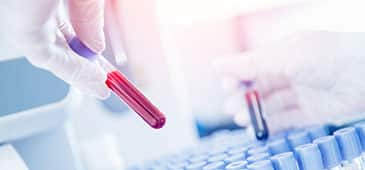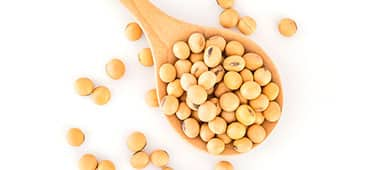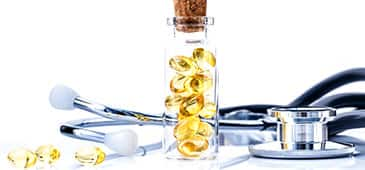
What's Hot
What's Hot
News flashes are posted here frequently to keep you up-to-date with the latest advances in health and longevity. We have an unparalleled track record of breaking stories about life extension advances.
Many drugs authorized for accelerated approval not confirmed as effective
 July 30 2021. Research reported on July 30, 2021 in The BMJ revealed that 112 out of 253 drugs authorized by the US Food and Drug Administration (FDA) for accelerated approval have not yet been confirmed as effective, but are still on the market.
July 30 2021. Research reported on July 30, 2021 in The BMJ revealed that 112 out of 253 drugs authorized by the US Food and Drug Administration (FDA) for accelerated approval have not yet been confirmed as effective, but are still on the market.
The drugs are allowed to be marketed under an accelerated approval pathway established by the FDA in 1992. The purpose of the program was to make drugs available to patients while allowing manufacturers to conduct post-approval studies to verify their products’ benefits. Just 16 of the drugs in the accelerated approval pathway have been withdrawn, of which the majority were demonstrated to be ineffective; however, some were withdrawn due to lack of confirmatory trials. Of 24 non-confirmed drugs that have been on the market for over five years, only six were associated with phase IV confirmatory trials, all of which were still in preparatory stages.
As an example, Pfizer’s celecoxib (Celebrex), which was granted accelerated approval in 1999 for the treatment of familial adenomatous polyposis (associated with an increased risk of colorectal cancer), was marketed for 12 years for the condition before the FDA requested Pfizer withdraw the drug for this indication due to failure to conduct efficacy trials.
A 2015 US Government Accountability Office review of the FDA’s expedited pathways reported that “data on post-market safety issues and studies were found to be incomplete, outdated, [and] to contain inaccuracies.”
“Despite the pathway’s good intentions to accelerate ‘the availability of drugs that treat serious diseases’ experts are concerned that it is now being exploited - to the detriment of patients, who may be prescribed a drug that offers little benefit and possible harm, and to taxpayers,” wrote BMJ reporter Elisabeth Mahase, who conducted the investigation. Nevertheless, she affirmed the usefulness of the accelerated pathway, despite the need for improvement.
—D Dye
Plant compounds reveal anticancer mechanisms
 July 28 2021. Research published on June 9, 2021 in Scientific Reports explored mechanisms involved in the cancer protective effects of 30 compounds derived from fruits and vegetables. The researchers hope that their findings will contribute to the formulation of new drugs that will have fewer side effects than drugs currently in use.
July 28 2021. Research published on June 9, 2021 in Scientific Reports explored mechanisms involved in the cancer protective effects of 30 compounds derived from fruits and vegetables. The researchers hope that their findings will contribute to the formulation of new drugs that will have fewer side effects than drugs currently in use.
“To create potent new drugs that will target only the tumor, it was necessary to determine how dietary compounds affect cell proteins in the prevention and treatment of cancer,” explained coauthor Grigory Zyryanov, who is a professor at the Russian Academy of Sciences. “Therefore, by modeling molecular mechanisms, we figured out how substances bind to proteins. This allowed us to determine the pool of therapeutic targets that the drugs will subsequently target. For example, these are anti-apoptotic (prevent apoptosis) and pro-apoptotic (induce apoptosis) proteins, protein kinases, and others. But a key drug target is phosphatidylinositol-3-kinase . . . This enzyme influences mutations in cancer, rearrangement, and amplification of genes.”
Compounds investigated in the study included emodin, eugenol, gingerol, sulforaphane, linalool, catechin, oleanolic acid, ursolic acid, curcumin, yakuchinone-A, pinusolide, alpha-boswellic acid, oleandrin, sesquiterpene lactone-326, resveratrol, triterpenoid, beta-boswellic acid, anethole, capsaicin, glycolic acid, quercetin, genistein, ellagic acid, flavopiridol, zerumbone, garcinol, guggulsterone, parthenolide, halogenated monoterpenes and silibinin. Of these compounds, silibinin, flavopiridol, oleandrin, ursolic acid, alpha-boswellic acid, beta-boswellic acid, triterpenoid, guggulsterone and oleanolic acid had the greatest binding affinity with phosphatidylinositol-3-kinase alpha (P13K), which is involved in functions that can contribute to cancer. Other targets identified as binding with various compounds included PKC-η, Ras and H-Ras.
“We assumed that the foods we selected for the study had anti-cancer properties, but this needed to be verified,” Dr Zyryanov noted. “As a result, we found out that diseased cells stop development under the influence of certain combinations of food compounds.”
—D Dye
Lower risk of diabetes found in green tea drinkers
 July 26 2021. The July 2021 issue of the American Journal of Clinical Nutrition reported a lower risk of developing diabetes as well as a decreased risk of premature mortality among those with pre-existing diabetes in association with daily intake of green tea.
July 26 2021. The July 2021 issue of the American Journal of Clinical Nutrition reported a lower risk of developing diabetes as well as a decreased risk of premature mortality among those with pre-existing diabetes in association with daily intake of green tea.
Jia Nie and colleagues evaluated data from 26,162 diabetics and 461,074 nondiabetics who were between the ages of 30 and 79 years upon enrollment in the China Kadoorie Biobank. Questionnaire responses obtained at enrollment provided information concerning type and quantity of tea consumed.
Nondiabetic participants were followed for an 11.1-year median period, during which 17,434 cases of type 2 diabetes were diagnosed. The risk of developing diabetes was 3% lower among daily tea drinkers compared to those who reported no tea consumption during the previous year. Consuming tea every day for at least 30 years was associated with a 9% lower diabetes risk, and drinking green tea daily was associated with an 8% reduction.
Among diabetics, 6,572 deaths occurred during a 10.6-year median. Diabetics who drank green tea daily had a 10% lower risk of mortality during this period than those who did not drink tea. Consuming tea daily for 10-29 years was associated with an 18% lower mortality risk. When causes of death were examined, diabetics who consumed tea every day had a 14% lower risk of cardiovascular mortality.
“To the best of our knowledge, this is by far the largest prospective cohort study that comprehensively investigated the association of tea consumption with long-term risk of type 2 diabetes and risk of death and complications among patients with diabetes,” the authors announced. “Daily green tea consumption was associated with a lower risk of incident type 2 diabetes and a lower risk of all-cause mortality in patients with diabetes, but the associations for other types of tea were less clear.”
—D Dye
CoQ10 supplementation associated with improved trauma patient outcomes
 July 23 2021. Findings from a trial reported on July 12, 2021 in the Journal of Nutritional Science revealed benefits for hospitalized trauma patients who were given supplements that contained coenzyme Q10.
July 23 2021. Findings from a trial reported on July 12, 2021 in the Journal of Nutritional Science revealed benefits for hospitalized trauma patients who were given supplements that contained coenzyme Q10.
The trial enrolled 40 men and women with traumatic injury and low plasma levels of CoQ10. Participants received a placebo or 400 milligrams CoQ10 daily for seven days. Blood samples collected at the beginning and end of the trial were analyzed for interleukin 6 (IL-6), which may be elevated during inflammation, and the oxidative stress markers malondialdehyde (MDA) and thiobarbituric acid reactive substances (TBARS). Body composition was also assessed at these time points, as well secondary outcomes that included Sequential Organ Failure Assessment (SOFA) and the Glasgow Coma Scale (GCS).
While interleukin-6 levels at the beginning of the study were similar between the CoQ10 and placebo groups at an average of 175.05 pg/mL and 177.82 pg/mL, they were reduced by 76.99 pg/mL in the CoQ10 group and 17.35 pg/mL in the placebo group. MDA values averaged 232.37 picograms per milliliter (pg/mL) and 239.96 pg/mL and were lowered by 88.84 pg/ml among participants who received CoQ10 and by 26.23 pg/mL among those who received a placebo. In comparison with the placebo group, fat free mass, skeletal muscle mass and body cell mass increased among those who received CoQ10. GCS and SOFA scores, and duration of hospital stay, ICU stay and ventilator use also improved among treated patients.
“To date, no randomized clinical trial study has been conducted to evaluate the effect of CoQ10 supplementation in traumatic mechanical ventilated patients and we hypothesized that CoQ10 administration in these patients could have beneficial effects on biochemical and clinical factors,” the authors wrote. “We have shown that CoQ10 could improve some of the clinical and anthropometric parameters in patients with a traumatic injury.”
—D Dye
Decreased plasma SAMe levels associated with increased mortality risk during 9.2-year period
 July 21 2021. A study reported on June 30, 2021 in the American Journal of Clinical Nutrition revealed a greater risk of mortality during 9.2 years of follow-up among men and women with low levels of S-adenosylmethionine (SAMe), a compound that is made in the body from the amino acid methionine.
July 21 2021. A study reported on June 30, 2021 in the American Journal of Clinical Nutrition revealed a greater risk of mortality during 9.2 years of follow-up among men and women with low levels of S-adenosylmethionine (SAMe), a compound that is made in the body from the amino acid methionine.
S-adenosylmethionine is a methyl donor, which donates methyl groups (consisting of consisting of carbon and hydrogen) in various physiologic processes. SAMe can be converted to S-adenosylhomocysteine (SAH), which can be transformed into homocysteine. Homocysteine, when elevated, is a risk factor for cardiovascular disease; however, it can be converted to the amino acid cysteine via the transsulfuration pathway or remethylated to methionine.
The study included 1,553 coronary artery disease patients who participated in the Guangdong Coronary Artery Disease Cohort, which is a study designed to investigate factors involved in coronary artery disease progression. Blood samples collected after enrollment were analyzed for plasma SAMe, plasma SAH and other factors.
During a median 9.2 years of follow-up, there were 321 deaths, of which 227 were attributable to cardiovascular diseases. Subjects whose plasma SAMe levels were among the lowest 25% of participants had a 59% higher adjusted risk of dying from any cause and more than twice the risk of cardiovascular mortality than those whose levels were among the top 25%. Having a low plasma ratio of SAMe to SAH was also associated with a greater risk of all-cause and cardiovascular mortality.
The authors noted that supplementing with SAMe has been shown to decrease injury-induced carotid intima thickness and improve endothelium-dependent vasodilation in mice, which suggests that SAMe may have a protective role against cardiovascular disease.
“Our data show a significant inverse relation between plasma SAMe and risk of mortality in patients with coronary artery disease after adjustment for homocysteine, SAH, and other cardiovascular disease risk factors,” they concluded.
—D Dye
JAMA study concludes coffee does not cause abnormal heart rhythm
 July 19 2021. A large study reported in JAMA Internal Medicine on July 19, 2021 failed to uncover any greater risk of experiencing abnormal heart rhythms known as cardiac arrhythmias among people who consumed coffee. In fact, coffee drinking appeared to have a protective effect against arrhythmia.
July 19 2021. A large study reported in JAMA Internal Medicine on July 19, 2021 failed to uncover any greater risk of experiencing abnormal heart rhythms known as cardiac arrhythmias among people who consumed coffee. In fact, coffee drinking appeared to have a protective effect against arrhythmia.
“The notion that caffeine increases the risk of cardiac arrhythmias is common,” wrote authors Eun-jeong Kim, MD, and colleagues of the University of California, San Francisco. “However, evidence that the consumption of caffeinated products increases the risk of arrhythmias remains poorly substantiated.”
The study included 386,258 participants in the UK Biobank, which is a prospective study of men and women aged 40 to 69 years residing in the United Kingdom. Questionnaire responses provided information concerning frequency of coffee intake. Inpatient and outpatient records were assessed to determine the incidence of initial diagnoses of atrial fibrillation or atrial flutter, supraventricular tachycardia, ventricular tachycardia, premature atrial complexes, and premature ventricular complexes. Subjects who had preexisting diagnoses of any of these tachyarrhythmias were excluded from the primary analysis.
During an average 4.5 years of follow-up, 16,979 participants developed an arrhythmia. Each cup of coffee regularly consumed was associated a 3% lower risk of the condition. The finding was significant for atrial fibrillation and/or flutter and supraventricular tachycardia. The participants’ genetic predisposition to alterations in caffeine metabolism did not have an impact on the risk of arrhythmia.
The authors observed that coffee has been associated with a number of benefits that are often attributed to the beverage’s antioxidant and anti-inflammatory effects. “The findings of this study failed to provide any evidence that coffee consumption heightens the risk of developing arrhythmias,” they wrote. “When coffee avoidance is recommended, we may withhold a beneficial substance that improves quality of life and longevity.”
—D Dye
Soy relieves hot flashes
 July 16 2021. The October 2021 issue of Menopause reported a study in which a plant-based diet with added soy relieved hot flashes in a majority of participants. The symptom affects as many of 80% of women during and after the menopause transition.
July 16 2021. The October 2021 issue of Menopause reported a study in which a plant-based diet with added soy relieved hot flashes in a majority of participants. The symptom affects as many of 80% of women during and after the menopause transition.
"Previous studies have shown that soy could be beneficial, so we decided to put a diet change to the test," commented study author Hana Kahleova, MD, PhD. "We believe that the combination is what is important.”
The study included 38 postmenopausal women who reported experiencing at least two hot flashes each day. Participants were randomized to a low-fat vegan diet that included ½ cup cooked soybeans per day, or to no dietary changes for 12 weeks. All women received a daily supplement that provided 100 micrograms vitamin B12. Responses to questionnaires administered before and after the diet period provided information concerning hot flashes and physical, psychosocial and sexual symptoms.
At the end of the study, women who consumed the low-fat diet plus soy experienced a greater decline in total and moderate to severe hot flashes compared to the control group. Fifty-nine percent of the group assigned to the diet reported becoming free of moderate and severe hot flashes by the end of the study. This group also had improvement in sexual symptoms.
As a possible contributor to soy’s benefits, the authors remarked that the soy compound daidzein can be metabolized by bacteria residing in the digestive tract to a compound known as equol that binds to estrogen receptors. The higher amount of equol produced in Asians compared to Western adults has been attributed to differences in diet.
“The study leaves for future investigations to identify the relative roles of a plant-based diet and soy supplementation, and the role of diet-induced microbiome changes in isoflavone metabolism,” the authors concluded.
—D Dye
Biologic age reversed with lifestyle improvement plus supplements
 July 14 2021. The April 15, 2021 issue of Aging published the results of an eight-week randomized trial which resulted in a reduction in biologic age among men who participated in lifestyle changes and consumed nutritional supplements.
July 14 2021. The April 15, 2021 issue of Aging published the results of an eight-week randomized trial which resulted in a reduction in biologic age among men who participated in lifestyle changes and consumed nutritional supplements.
"The combined intervention program was designed to target a specific biological mechanism called DNA methylation, and in particular the DNA methylation patterns that have been identified as highly predictive of biological age,” explained lead author Kara Fitzgerald, ND. “We suspect that this focus was the reason for its remarkable impact.”
The trial included 38 men between the ages of 50 and 72 years. Eighteen participants consumed a plant-based, low carbohydrate diet that included limited nutrient-dense animal proteins. The diet was supplemented with a vegetable and fruit powder and the probiotic Lactobacillus plantarum 299v. The group was advised to participate in a minimum of 30 minutes of exercise daily and to perform breathing exercises twice per day for stress reduction.
According to the Horvath DNAmAge clock, which evaluates DNA methylation patterns as a marker of biologic age, men who participated in the lifestyle program had scores that averaged 1.96 younger at the end of the program in comparison with the beginning, while control participants scored 1.27 years older. Additionally, triglycerides were reduced in the lifestyle program group.
“To our knowledge, this is the first randomized controlled study to suggest that specific diet and lifestyle interventions may reverse Horvath DNAmAge epigenetic aging in healthy adult males,” the authors announced.
“These early results appear to be consistent with, and greatly extend, the very few existing studies that have so far examined the potential for biological age reversal,” Dr Fitzgerald commented. “And it is unique in its use of a safe, non-pharmaceutical dietary and lifestyle program, control group, and the extent of the age reduction."
—D Dye
Testosterone replacement associated with lower risk of heart attack, stroke
 July 12 2021. Research presented at the Annual Congress of the European Association of Urology, held virtually July 9-12, 2021, revealed that testosterone replacement therapy was associated with a decreased risk of heart attack and stroke compared to no testosterone.
July 12 2021. Research presented at the Annual Congress of the European Association of Urology, held virtually July 9-12, 2021, revealed that testosterone replacement therapy was associated with a decreased risk of heart attack and stroke compared to no testosterone.
The study included over 800 men who had risk factors for heart attack and stroke. All were encouraged to make lifestyle changes to improve cardiovascular health. Four hundred twelve men were receiving long-term testosterone therapy.
During the ten-year study, there were 16 deaths and no heart attacks or strokes among testosterone-treated men. Among the remaining 393 untreated men, there were 74 deaths, 70 heart attacks and 59 strokes. After adjustment for age, heart attack and stroke risk was lowered by 25% among men under 55 years of age and by 15% among those over 60. Men treated with testosterone weighed less and had greater lean muscle mass, cholesterol levels, liver function, diabetes control and blood pressure than untreated men.
"Given that all these men would normally have been expected to suffer a heart attack or stroke in the next five to ten years, with no other intervention, it was a real surprise to see no cardiovascular events at all in the group on testosterone therapy,” commented researcher Omar Aboumarzouk. “For those at high risk of heart attack and stroke, who are deficient in testosterone, it's likely that bringing the hormone back to normal levels helps them to maximize the benefits of other steps necessary to improve their overall health. This includes increasing exercise levels, eating healthier food, giving up smoking and reducing alcohol consumption.”
"We believe that physicians treating patients with low testosterone, who are at high risk of heart attack or stroke, should consider testosterone therapy as one aspect of their treatment," he suggested.
—D Dye
Meta-analysis concludes safety and efficacy for curcumin against osteoarthritis
 July 9 2021. Results of a meta-analysis of clinical trial findings published in the May 2021 issue of Bioscience Reports add evidence to a positive effect for Curcuma longa extract and its active compound curcumin against the symptoms of osteoarthritis.
July 9 2021. Results of a meta-analysis of clinical trial findings published in the May 2021 issue of Bioscience Reports add evidence to a positive effect for Curcuma longa extract and its active compound curcumin against the symptoms of osteoarthritis.
Liuting Zeng of the Chinese Academy of Medical Sciences & Peking Union Medical College and colleagues selected 15 randomized trials that included a total of 1,621 participants with osteoarthritis for their analysis. Twelve of the trials compared the effects of extracts of Curcuma longa or curcumin to a placebo or a nonsteroidal anti-inflammatory drug (NSAID). Also included were a trial that compared the effects of Curcuma longa extract to a placebo in groups that both received NSAIDs, a trial that compared curcumin plus an NSAID to an NSAID alone, and a trial in which arthritis patients received a placebo, Curcuma longa extract or glucosamine sulphate alone, or a combination of Curcuma longa extract and glucosamine sulfate. Investigated outcomes included pain, joint function, daily living, sport and quality of life function, and biochemical factors.
Improvements in joint pain, function and stiffness associated Curcuma longa extract and curcumin were comparable to NSAIDs and greater than a placebo. Adverse events associated with Curcuma longa extract and curcumin were similar to a placebo and lower than those of NSAIDs.
Addition Curcuma longa extract or curcumin to NSAID therapy was also associated with improvement in joint pain, function and stiffness without an increase in adverse events. The authors remarked that “adding curcumin supplementation in the case of using NSAIDs may increase the efficacy and perhaps reduce the dosage of NSAIDs.”
They suggested that “Based on current evidence, it is recommended to use Curcuma longa extract and curcumin supplement for osteoarthritis patients for more than 12 weeks.”
—D Dye
Decreased UVB exposure is linked to higher colorectal cancer risk
 July 7 2021. An article published on July 5, 2021 in BMC Public Health revealed the finding of researchers at the University of California, San Diego of an association between low ultraviolet B (UVB) light exposure and a higher incidence of colorectal cancer. The authors of the report suggested that a decrease in the production of vitamin D, which is made in the body as a result of sunlight exposure, could explain the finding. “Vitamin D has been identified as a potential protective factor in the risk of developing colorectal cancer,” Vidya Lakshmi Purushothaman and colleagues wrote. “Intake of 1000 IU/day of vitamin D is shown to be associated with 50% lower risk.”
July 7 2021. An article published on July 5, 2021 in BMC Public Health revealed the finding of researchers at the University of California, San Diego of an association between low ultraviolet B (UVB) light exposure and a higher incidence of colorectal cancer. The authors of the report suggested that a decrease in the production of vitamin D, which is made in the body as a result of sunlight exposure, could explain the finding. “Vitamin D has been identified as a potential protective factor in the risk of developing colorectal cancer,” Vidya Lakshmi Purushothaman and colleagues wrote. “Intake of 1000 IU/day of vitamin D is shown to be associated with 50% lower risk.”
The researchers analyzed the relationship between global ultraviolet light levels in 2017 and the incidence of colorectal cancer in 2018 among residents of 148 countries that represent approximately 97% of the world’s population. They observed a correlation between low UVB exposure and a greater risk of colorectal cancer in all age groups. A significantly increased risk remained among over 45-year-olds after adjustment for skin pigmentation, life expectancy and other factors. "Differences in UVB light accounted for a large amount of the variation we saw in colorectal cancer rates, especially for people over age 45,” coauthor Raphael Cuomo remarked. “Although this is still preliminary evidence, it may be that older individuals, in particular, may reduce their risk of colorectal cancer by correcting deficiencies in vitamin D."
“This study supports the need for adequate public health programs to avoid vitamin D inadequacy at national and global levels, whether through screening those at risk, through selective supplementation, or through population-based measures such as food fortification,” the authors concluded. “Future studies can aim at identifying the cancer types which show significant improvement.”
—D Dye
Longevity record may soon be broken
 July 5 2021. The oldest documented human is Jeanne Calment of France, who survived to the age of 122 years. However, according to research conducted by Michael Pearce and Adrian E. Raftery of the University of Washington in Seattle, reported in the January–June 2021 issue of Demographic Research, Kane Tanaka of Japan, who is currently 118 years of age, has a chance of breaking that record. “We seek to quantify the probability that any person attains various extreme ages, such as those above 120, by the year 2100,” they wrote. “We use the exponential survival model for supercentenarians (people over age 110) of Rootzén and Zholud (2017) but extend the forecasting window, quantify population uncertainty using Bayesian population projections, and incorporate the most recent data from the International Database on Longevity to obtain unconditional estimates of the distribution of maximum reported age at death this century in a fully Bayesian analysis.”
July 5 2021. The oldest documented human is Jeanne Calment of France, who survived to the age of 122 years. However, according to research conducted by Michael Pearce and Adrian E. Raftery of the University of Washington in Seattle, reported in the January–June 2021 issue of Demographic Research, Kane Tanaka of Japan, who is currently 118 years of age, has a chance of breaking that record. “We seek to quantify the probability that any person attains various extreme ages, such as those above 120, by the year 2100,” they wrote. “We use the exponential survival model for supercentenarians (people over age 110) of Rootzén and Zholud (2017) but extend the forecasting window, quantify population uncertainty using Bayesian population projections, and incorporate the most recent data from the International Database on Longevity to obtain unconditional estimates of the distribution of maximum reported age at death this century in a fully Bayesian analysis.”
The International Database on Longevity provides information concerning supercentenarians from the United States, Canada, Japan and 12 European countries. "This is a very select group of very robust people,” Pearce and Raftery observed.
They predicted that cases of extreme longevity will continue to rise and that a lifespan of 125 to 130 years is possible. Their calculations revealed a 99% probability of a person living to 124 years old and a 68% chance of someone living to 127 years by 2100.
"People are fascinated by the extremes of humanity, whether it's going to the moon, how fast someone can run in the Olympics, or even how long someone can live," commented Pearce, who is a doctoral student in statistics at the University of Washington. "With this work, we quantify how likely we believe it is that some individual will reach various extreme ages this century."
—D Dye
Consuming more omega 3 fatty acids could lower headache frequency
 July 2 2021. Findings from a trial reported on July 1, 2021 in The BMJ revealed a lower incidence a of migraine headaches in men and women who consumed a diet rich in omega 3 fatty acids.
July 2 2021. Findings from a trial reported on July 1, 2021 in The BMJ revealed a lower incidence a of migraine headaches in men and women who consumed a diet rich in omega 3 fatty acids.
The trial included 182 participants who suffered with migraines during 5 to 20 days per month. Participants were given a high omega 3 diet that provided 1.5 grams per day EPA plus DHA, a high omega 3/reduced omega 6 diet, or a control diet that provided average US intakes of EPA and DHA and 7.2% of daily calories from the omega 6 fatty acid linoleic acid for 16 weeks. (Greater omega 6 intake is associated with an increase in inflammation.) Blood samples collected at the beginning and end of the treatment period were analyzed for 17-HDHA, a metabolite of DHA that is a precursor of specialized proresolving mediators that promote a healthy postinflammatory response. A six-item headache impact test (HIT-6) was completed at the beginning of the study and at the 16-week follow-up visit. Headache frequency was tracked via the completion of electronic diary entries.
Both diets that contained high amounts of omega 3 were associated with an increase in 17-HDHA in comparison with the control diet at the end of follow-up. Headache impact test scores also improved in the high omega 3 groups, although they were not significantly different than the control group’s scores.
Headache frequency declined by 2 days per month in the high omega 3 diet group and by 4 days in the high omega 3/reduced omega 6 group. Time spent daily with a headache was lowered by 1.3 hours in the high omega 3 group and by 1.7 hours in the high omega 3/reduced omega 6 group.
“This study provides a biologically plausible demonstration that pain can be treated through targeted dietary alterations in humans,” the authors concluded.
—D Dye

